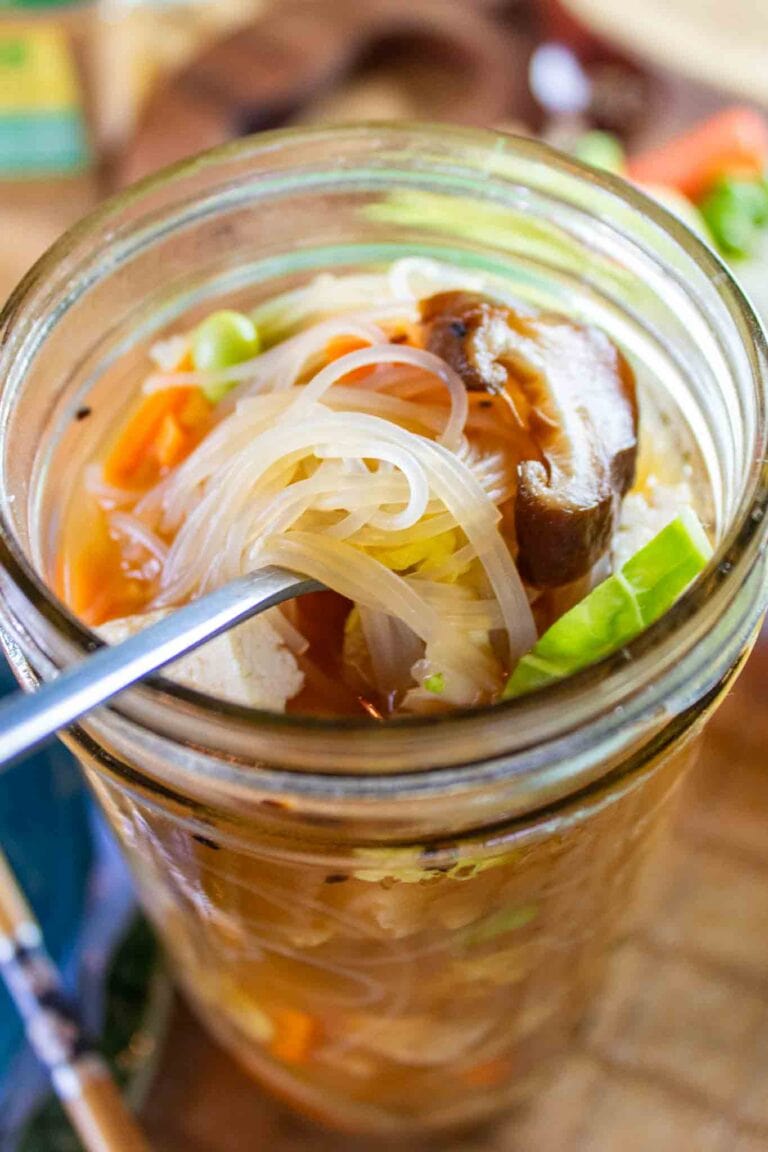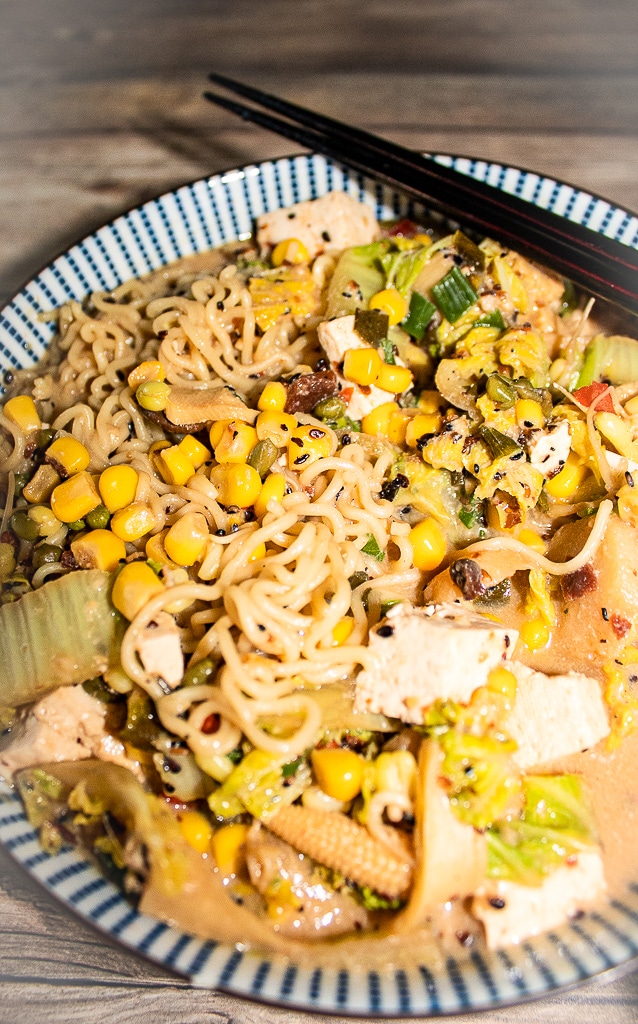Vegetable Udon Noodle Soup
This delicious udon vegetable noodle soup recipe is centered around thick chewy udon noodles in a rich dashi-based broth with vegetables, tofu, and tender mushrooms. It is a warm, comforting vegan soup that will satisfy the whole family.

The inspiration for this veggie udon noodle recipe is from a Japanese noodle dish called sukiyaki. Sukiyaki is traditionally made with marbled beef that is seared/cooked, in a cast iron pot over a fire or burner, directly in front of you.
In this Japanese udon recipe, I have taken the authentic signature ingredients of the sukiyaki sauce and made a warm flavorful udon dashi-based broth and added a variety of vegetables, noodles, and tofu that make it not only a healthy, whole food, and plant-based version, but also delicious! Check out our list of vegan Asian recipes for even more inspiration.
If you like to keep it super simple, with only about 15 minutes, you can even meal-prep these easy Asian Mason Jar Soups to have on hand for grab-and-go meals.
Sukiyaki was one of my favorite dishes before going plant-based. Unfortunately, with my rheumatoid diagnosis, it was quickly removed from my diet options. In this version, I have removed all the meat, fat, eggs, and oil that made it off-limits for me with an autoimmune disease. Instead, I have enhanced it with lots of healthy vegetables and protein options while protecting the integrity of the delicious, sweetened soy sauce flavor that has made it one of our family’s favorites for the last 30+ years.
This is the perfect family-style dinner to cozy up and share with your friends and family during the winter months and holidays. It will warm your stomach and heart with its authentic Japanese flavors.
Reasons you will love this soup
- Hearty and Nourishing: This plant-based vegetable udon soup is packed with fresh vegetables and thick, chewy udon noodles, providing a satisfying and nutritious meal.
- Oil-Free and Healthy: Completely oil-free, this soup is a light yet flavorful option for those seeking a heart-healthy, low-fat meal without sacrificing taste.
- Customizable and Vegan-Friendly: This versatile soup is 100% plant-based and can easily be customized with your favorite veggies and spices, making it suitable for any vegan or health-conscious diet.
Ingredients you will need

Dashi Japanese soup broth– This is a key ingredient in many Japanese recipes, soups, and sauces that we use frequently, and you can easily make it at home using only 2 ingredients plus water. Be sure to try our miso ramen soup and somen cold noodle soup recipes that also use dashi. While you are making dashi, consider repurposing the dashi stock ingredients to make furikake rice seasoning.
Udon noodles– These are thick and white and have a glossy sheen when cooked. They have a mild flavor and a chewy doughy texture and are made from only three ingredients- wheat, salt, and water. They taste amazing in soups and stir-fries. Try our udon noodle stir fry to see what I mean!
Glass Noodles– Also called harusame noodles. They are thin, transparent, gluten-free noodles made of potato or sweet potato starch. You can use these quick-cooking Japanese noodles in spring rolls, noodle salads, stir-fries, soups, and hot pot dishes. They are clear, silky-smooth, and have a delightful chewy texture. Their neutral flavor soaks up broths, soups, and seasonings well.
Daikon This is a Japanese radish. It is a long white root vegetable with green leaves on top; it somewhat resembles a very large carrot. Daikon is widely used in Japanese cuisine and can be eaten raw, cooked, grated, and pickled. It has a crisp crunchy texture that becomes tender and juicy as it soaks up the flavors in sauces and soups when cooked.
Vegetables– Onions, mushrooms, cabbage, and bean sprouts are some of my favorite veggies to use in this soup. Feel free to customize the portions and varieties of vegetable ingredients to suit your personal preferences.
Soy curls– Used as a vegan meat substitute, soy curls are made from only one ingredient–non-GMO soybeans. There is nothing else added to them during processing–no salt or preservatives–and nothing is taken away from the whole bean. They can be purchased online and in some grocery stores. We have lots of soy curl recipes for you to try.
Sake – The alcohol in sake evaporates but leaves a distinct and important flavor.
Why use sake?
Sake is a Japanese wine made from fermented rice. A lot of traditional Japanese soup broths include a combination of soy sauce and sake because they blend well together and create an almost magical complexity to the broth. The alcohol evaporates from the broth as it cooks and only the distinct sake flavor is left.
What are udon noodles?
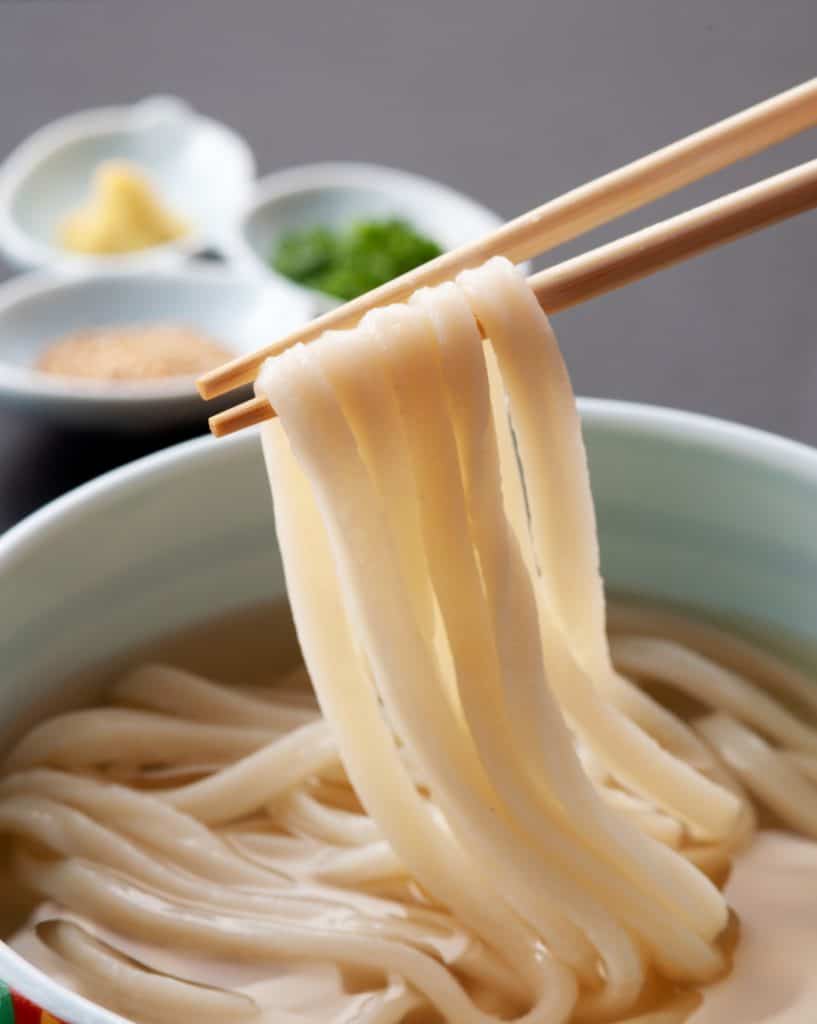
Udon noodles make up an important part of Japanese cuisine. Unlike the more readily known soba noodles, udon noodles are thicker and white, and have a glossy sheen when cooked. They have a mild flavor and a chewy doughy texture and are made from only three ingredients- wheat, salt, and water. The best quality I saved for last, they taste amazing in soups and stir-fries!
We don’t easily find fresh Japanese udon noodles where we live, on the East Coast, but most Asian grocers carry them in both frozen and dried aisles. They can also be frequently found at health food stores and even ordered online for your udon soup recipes.
How to make vegetable udon noodle soup
The recipe card at the bottom of the page has the full list of ingredients with measurements and instructions.

Step #1: Prep Work– You’ll want to make your kombu dashi ahead of time. Dashi can be stored in the fridge for up to 14 days or frozen for up to three months. If you need to make it the day of, do it at least 2-3 hours beforehand for best results.
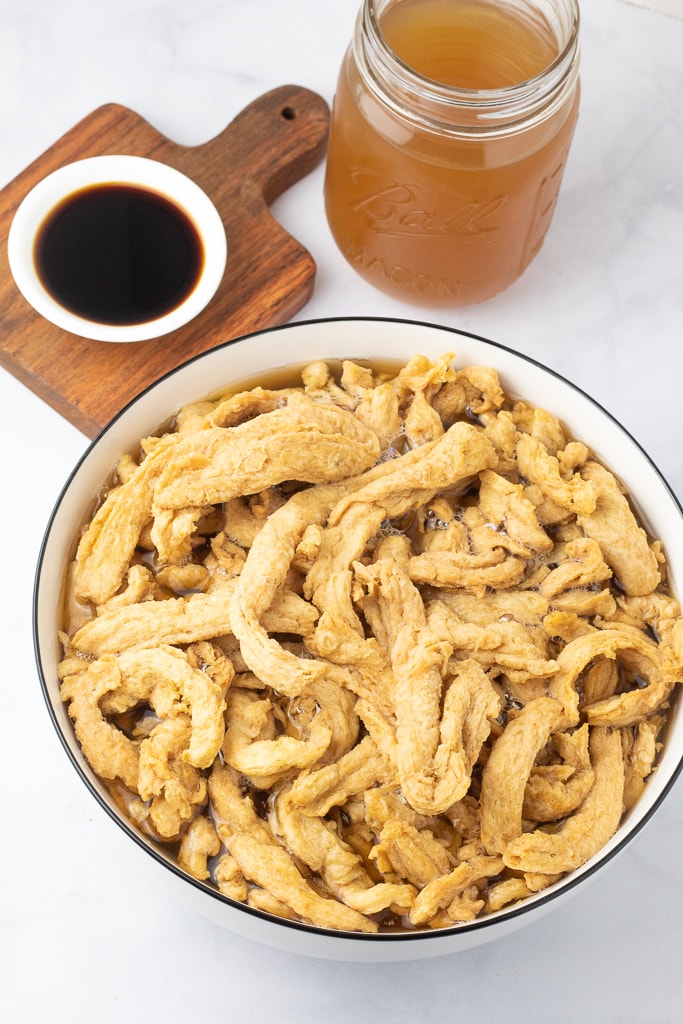
Step #2: Rehydrate the soy curls in vegetable broth for 10 minutes and cut into 2” strips.
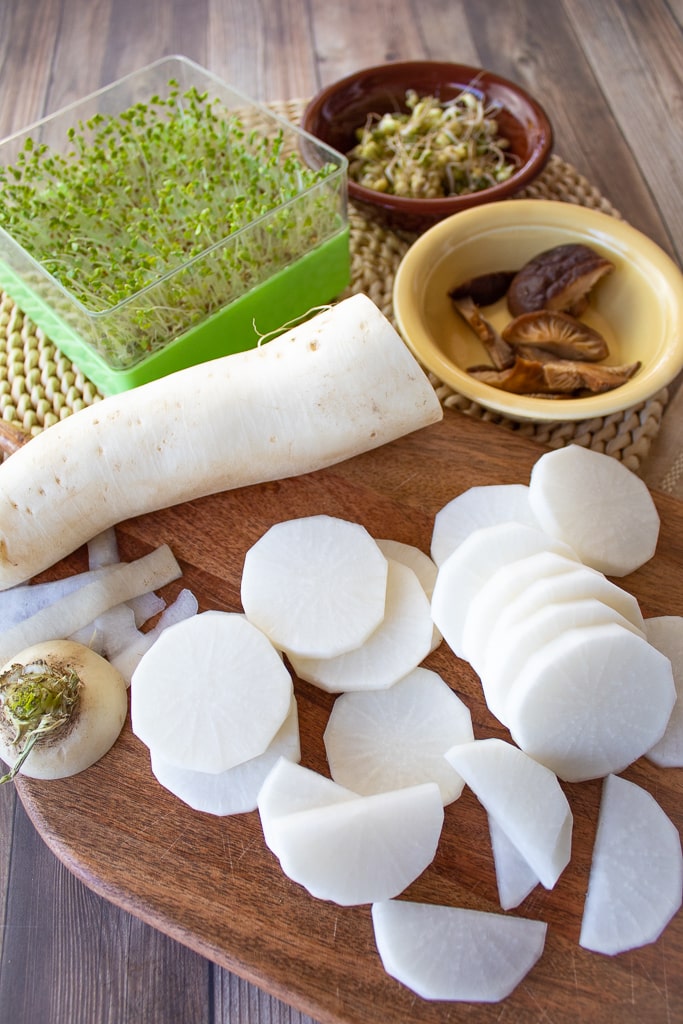
Step #3: Prepare Ingredients– Drain, and slice all of the vegetables so they will be ready to add as soon as the soup base is ready. Slicing the veggies into strips or squares aids in eating with chopsticks.
Step #4: Boil the daikon disks in the kombu dashi soup base in a stock pot for 10 minutes to soften them before adding the rest of the ingredients.
Step #4: Once the daikon is soft enough to pierce with a fork, begin adding the rest of our ingredients to the stockpot in the following order. First, add the sake to the broth to allow time for the alcohol to evaporate.
Step #5: Next, add the soy sauce and half of the sugar and stir until the sugar is completely dissolved.
Step #4: Start adding the onions, mushrooms, udon noodles, napa, soy curls, green onions, glass noodles, and tofu. I layer them in this order to protect the more fragile ingredients from overcooking and crumbling from the weight of the other ingredients.
Step #5: Once all the ingredients are in the pot, sprinkle the remaining sugar over the top, cover, and simmer over medium-high heat for an additional 10 minutes.
Step #6: Add the sprouts about two minutes before cutting off the heat. They are tender and will only take a second to steam.
Step #7: When the glass noodles are clear and soft and all the ingredients have simmered in the soup base enough to absorb all the wonderful flavors, it’s time to eat! Serve in individual bowls with chopsticks (or forks) and a soup spoon. This dish is best served hot. You can refrigerate leftovers for up the three days.
Pro tips and suggestions
In this recipe, I like to slice the daikon first because it will need to cook the longest. If you don’t need the entire daikon root, cut it in half and use the top portion, the part with the leaves attached, first. Removing the leaves (that absorb moisture) extends the shelf life of the daikon radish. Wrap the unused portion of daikon tightly in plastic wrap and store it in the fridge for future use. Slice off the top (the leafy part) and peel the section you will be using with a vegetable peeler, just like you would a carrot, and then slice into ¼” circular disks.
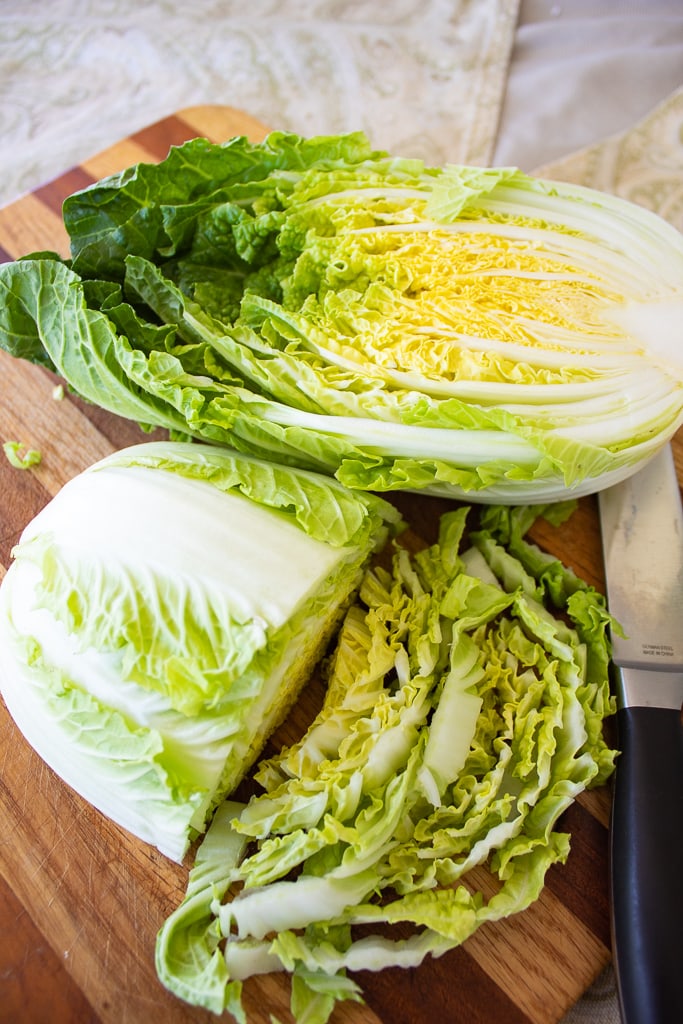
If you’re using a new full head of napa cabbage, instead of slicing the strips horizontally from top to bottom, first slice it long-wise, splitting it straight down the middle. This way you will have two complete halves, one for now and one for your next meal. You can see the texture of napa cabbage changes from leafy near the top to crunchy as you work your way down and this way you get to experience all the textures with each meal. The photo above shows what I mean.
If you want to meal prep and make this an easy weeknight meal, you can make the sukiyaki udon sauce ahead and store it in an airtight container in the refrigerator. Prepare your toppings (veggies and tofu) a day ahead and store them in a separate covered container until you are ready for them. When you are ready to make this recipe, just pour the broth into the stock pot over the vegetables and noodles when you are ready to cook and serve them.
Frequently Asked Questions
Traditional udon noodles are typically vegan, made from just wheat flour, water, and salt. However, always check the packaging, as some brands may add non-vegan ingredients.
Popular vegetables for udon soup include mushrooms, spinach, bok choy, carrots, zucchini, and green onions. You can mix and match your favorites for a customized bowl.
Yes! Adding tofu, tempeh, or seitan can provide extra protein and texture to your udon soup, making it more filling and nutritious.

More Vegan Asian Noodle Soup Recipes
If you try this recipe, please let us know how you like it by rating it and leaving a comment. We love to hear from you!
Want to Save This Recipe?
Enter your email & I’ll send it to your inbox. Plus, get great new recipes from me every week!
By submitting this form, you consent to receive emails from EatPlant-Based
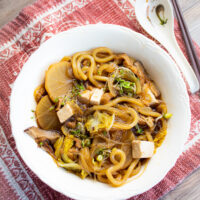
Udon Noodle Soup with Vegetables
Ingredients
- 7 cups dashi broth (recipe linked)
- 2 cups daikon cut into 1/4" circles
- 1/3 cup sake
- 3/4 cup low-sodium soy sauce
- 1/2 cup sweetener (pure cane sugar, date sugar, etc)
- 1 large onion sliced into long thin strips
- 1/2 cup shitake or king oyster mushrooms sliced thin
- 2 bundles udon noodles
- 2 cups napa or bok choy cabbage sliced into 2" squares/see photo above
- 1 cup soy curls, rehydrated
- 3 green onions sliced into 2" diagonal strips
- 1 bundle glass noodles (1" diameter, about the circumference of a quarter)
- 14 oz tofu (drained, pressed, and diced into small squares)
- 1/2 cup bean sprouts
Instructions
Prep Work
- You’ll want to make your kombu dashi ahead of time. Dashi can be stored in the fridge for up to 14 days or frozen for up to three months. If you need to make it the day of, do it at least 2-3 hours beforehand for best results.
- Rehydrate the soy curls in vegetable broth for 10 minutes and cut into 2” strips.
Prep Ingredients
- To begin, you will need to wash, drain, and slice all of the vegetables so they will be ready to add as soon as the soup base is ready. Slicing the veggies into strips or squares aids in eating with chopsticks.
Cooking Instructions
- Begin by boiling daikon disks in the kombu dashi soup base in a stock pot for 10 minutes to soften them before adding the rest of the ingredients.
- Once the daikon is soft enough to pierce with a fork, begin adding the rest of our ingredients to the stockpot in the following order.
- First, add the sake to the broth to allow time for the alcohol to evaporate.
- Next, add the soy sauce and half of the sugar and stir until the sugar is completely dissolved.
- Now it’s time to start adding the onions, mushrooms, udon noodles, napa, soy curls, green onions, glass noodles, and tofu. I layer them in this order to protect the more fragile ingredients from overcooking and crumbling from the weight of the other ingredients.
- Once all the ingredients are in the pot, sprinkle the remaining sugar over the top, cover, and simmer over medium-high heat for an additional 10 minutes.
- Add the sprouts about two minutes before cutting off the heat. They are tender and will only take a second to steam.
- When the glass noodles are clear and soft and all the ingredients have simmered in the soup base enough to absorb all the wonderful flavors, it’s time to eat!
- Serve in individual bowls with chopsticks (or forks) and a soup spoon. This dish is best served hot. You can refrigerate leftovers for up the three days.
Video
Notes
Nutrition
Disclaimer
To obtain the most accurate representation of the nutritional information in a given recipe, you should calculate the nutritional information with the actual ingredients used in your recipe, using your preferred nutrition calculator. You are solely responsible for ensuring that any nutritional information provided is accurate, complete, and useful.
About the Chef
Drenda-Michell Brennan lived in Japan in the 1980s and 90s where she enjoyed spending much of her time visiting the kitchens of family and friends, watching and learning to prepare traditional Japanese cuisine. She is the mother of three Japanese-American grown children and grandmother (HuneyGram) to nine grandchildren. Read More…

